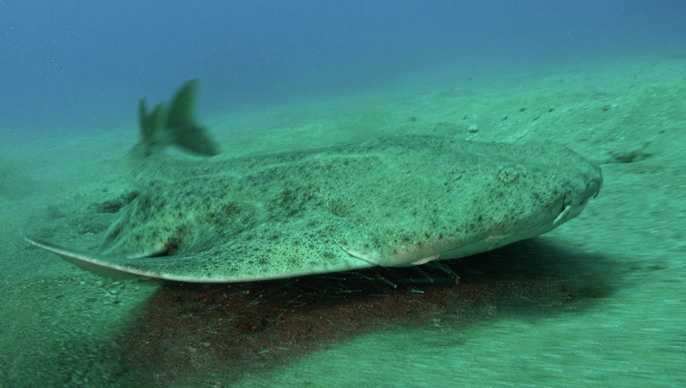Hello ladies and gents this is the Viking telling you that today we are talking about
ANGEL SHARKS
The angelsharks are a group of sharks in the genus Squatina of the family Squatinidae. They commonly inhabit sandy seabeds close to 150m in depth. Many species are now classified as critically endangered by the International Union for Conservation of Nature. Once common over large areas of the Northeast Atlantic from Norway, Sweden, Morocco, and the Canary Islands, to the Mediterranean and Black Seas, there is now significant fishing pressure which has resulted in significant population declines.
Squatinidae are unusual in having flattened bodies and broad pectoral fins that give them a strong resemblance to rays. This genus is the only one in its family and order Squatiniformes. They occur worldwide in temperate and tropical seas. Most species inhabit shallow temperate or tropical seas, but a few species inhabits deeper water, down to 1,300 m (4,300 ft). Angel sharks are sometimes called monkfish, although this name is also applied to members of the genus Lophius.
While some species occur over a wide geographic range, the majority are restricted to a smaller area. Restriction in geographic range might be as a result of the behavior of Squatina species, which are ambush predators with a corresponding stationary bottom-dwelling habit. Thus, trans-ocean migration is extremely unlikely, even though large-scale coastal migratory patterns have been reported in species such as Squatina squatina.
Commercial value
Prior to the late 1980s, the Pacific angel shark was considered a "munk fish". It was a byproduct of commercial gillnetting, with no commercial appeal and was used only for crab bait. In 1977, Michael Wagner, a fish processor in Santa Barbara, California, in cooperation with local commercial fisherman, developed the market for angel sharks.The annual take of angel shark in 1977 was an estimated 147 kg. By 1985, the annual take of angel shark on the central California coast had increased to more than 454 metric tons or an estimated 90,000 sharks.
The population declined dramatically and is now regulated. Due to Angel Sharks living very close to the shore they often got captured, when there weren't the target for the fishermen. In 1991, the use of gillnets in nearshore state waters of California was forbidden, and fishing was restricted in a larger portion of the Pacific Angel Shark's range. This helped the Angel Sharks not get caught more often.
And as always have a chilled day from the Viking.
In April 2008, the UK government afforded the angel shark full protection under the Wildlife and Countryside Act. Once considered abundant in the Atlantic Ocean, the angel shark (Squatina squatina) was classified as "critically endangered" in 2010

Comments
Post a Comment